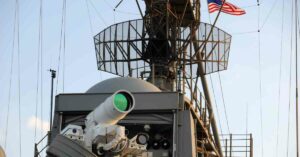
77 Rescued After LNG Carrier Collides With Cargo Ship Off South Korea
February 22, 2024
Vitol Bunkers Takes Delivery Of Asia’s First Biofuel Bunker Barge In Singapore
February 23, 2024
The most recent attacks on merchant vessels in the waters of the Red Sea have highlighted an issue: launching a $2 million air defence missile for a $2,000 drone is a poor trade. Not only financially but also because warships can be loaded with only a limited number of missiles. Laser weapons help avoid such problems, at least in theory. As long as there‘s adequate electricity, they can fire continuously. And do so more cheaply than the missile launchers/air defence cannons, with costs as low as a dollar for each shot or lower.
However, the HEL, or the current high-energy lasers, suffer fundamental issues that have inhibited their uses. Not running out of ammunition is a good thing, but the cost is the need to have easy access to vast amounts of electricity. Continuously firing the lasers also generates a significant amount of heat that limits firing time and needs bulky cooling systems unsuitable for mounting on small platforms like drones.

What is the US Navy’s solution on the matter?
Come up with lasers that use the equivalent of a rifle magazine. But instead of containing bullets, the clips will have limited battery power. When the laser drains a magazine, swap it out with a fresh one, as the depleted magazines get recharged. The replacement magazines extend an opportunity to forgo the ‘near infinite life’ needs and explore the potential advantages of limited life (hundreds of shots) and expendable, replaceable munition-type power as well as cooling sub-assemblies, per the Navy Small Business Innovation Research (abbreviated as the SBIR) solicitation.
The Navy has been aiming for a magazine that can help power a 20-kilowatt small weapon and operate on a 1-micron wavelength. Since it would be air-cooled instead of being cooled with water, the laser’s weight would not cross 20 pounds. That is not a highly powerful system compared to the current lasers that range from 300-kilowatt devices up to 50-kilowatt weapons mounted on any Stryker-armored vehicles for short-range air defence. However, it would be ideal for the prize that the Navy seeks: a laser weapon that is compact enough to disable the tiny drones.
The Navy said the demands on infinite duty cycle cooling by water chillers deteriorate, resulting in limited operational employment. Relieving the design as well as the alignment constraints of separating the systems and examining rechargeable magazines for cooling and electrical power in the deployment of such kilowatt-class HEL systems may bear lucrative benefits on small platforms (ground/airborne, including the unmanned weapon platforms) and offers unique research abilities.
Tiny lasers installed on unmanned ground vehicles or aerial drones could significantly modify the battlefield. They can dramatically lessen the threat posed by drone swarms or anti-ship missiles, which have the potential to saturate modern air defence systems. However, lasers have not yet shown their value in combat. Even after the Navy demonstrated a laser weapon on a vessel in the Persian Gulf ten years ago, air defence missiles and guns are still being used instead of lasers.
Reference: Business Insider
US Navy Aims To Use Rechargeable Magazines For Laser Defence Systems appeared first on Marine Insight – The Maritime Industry Guide
Source: Maritime Shipping News


